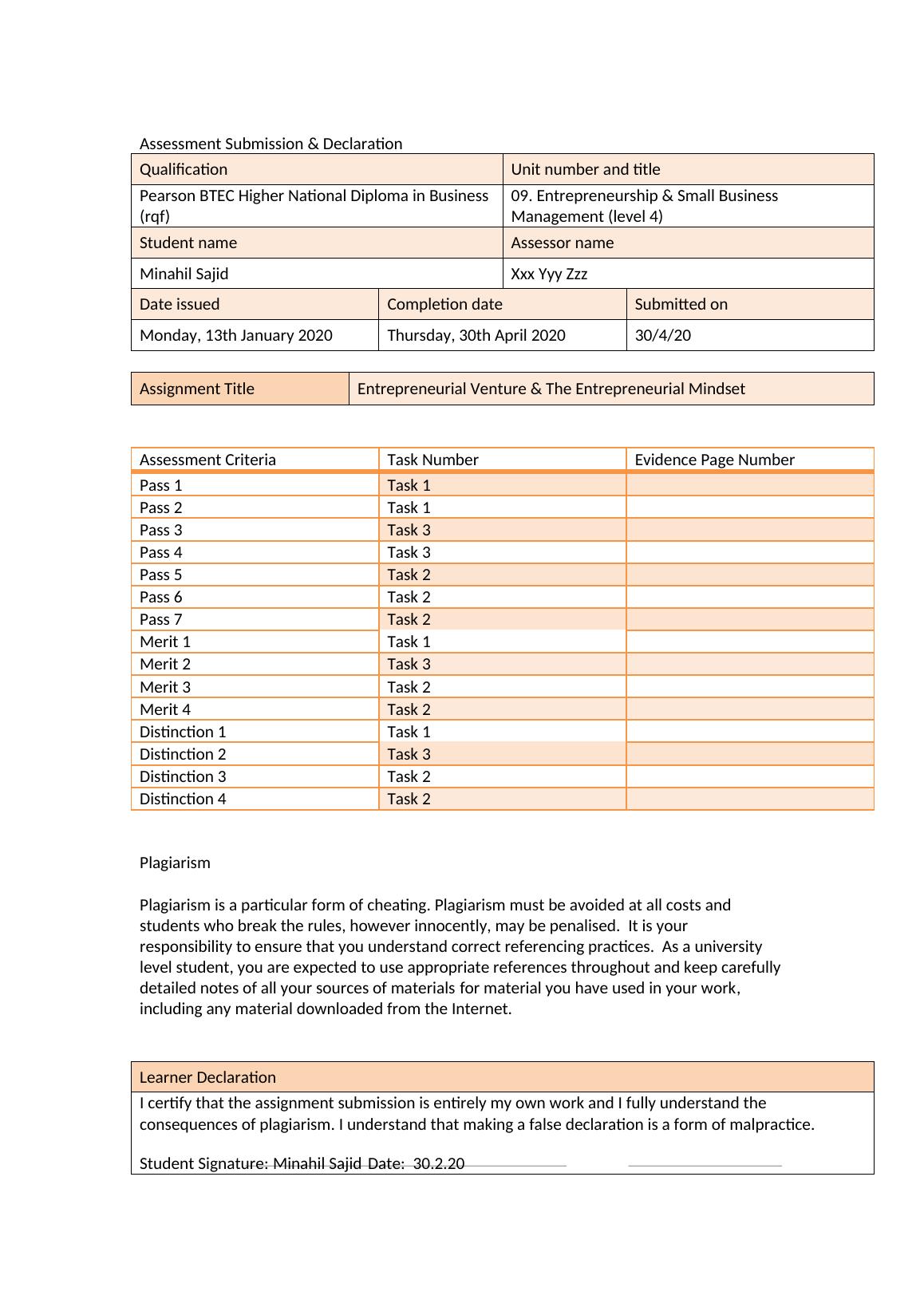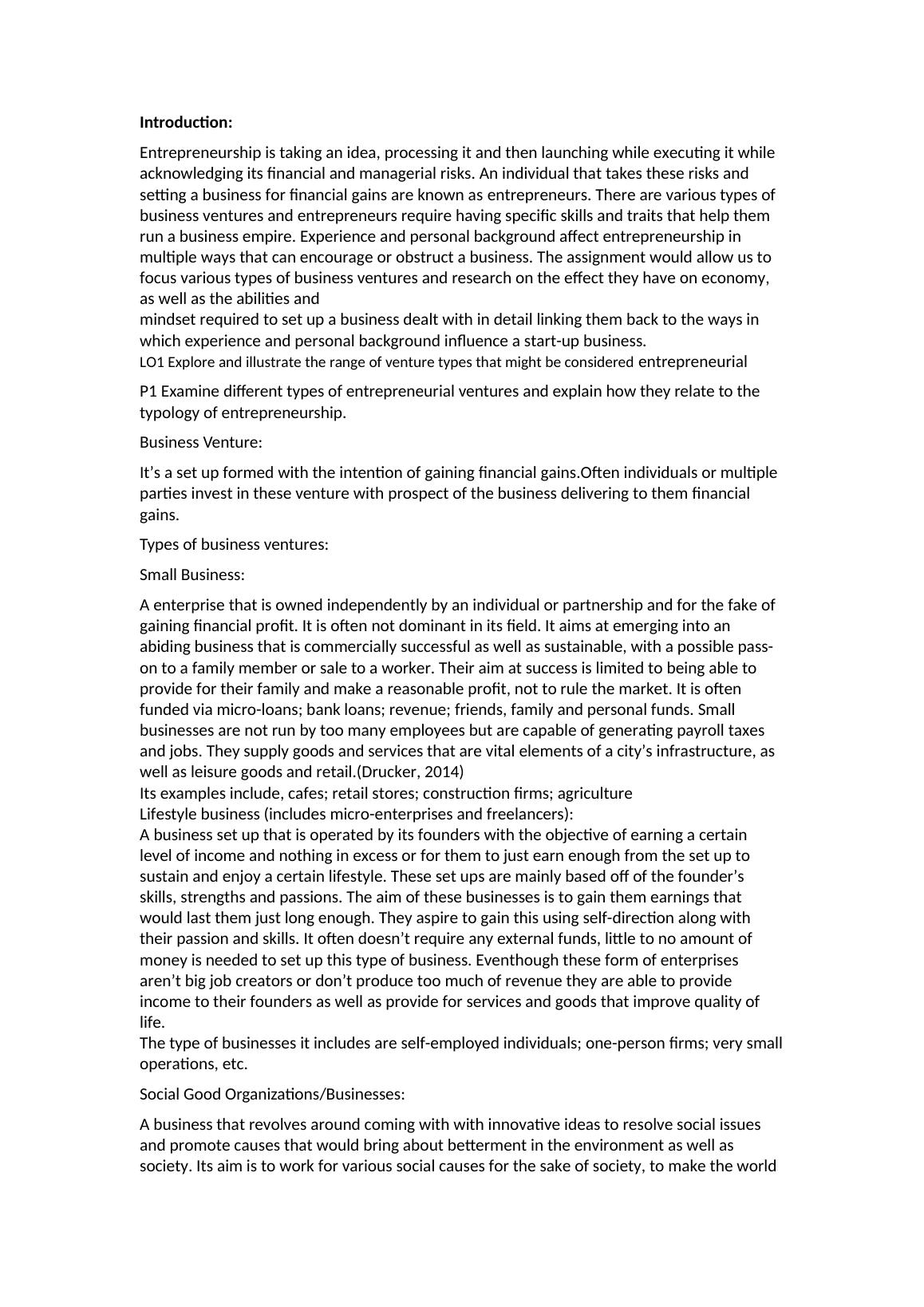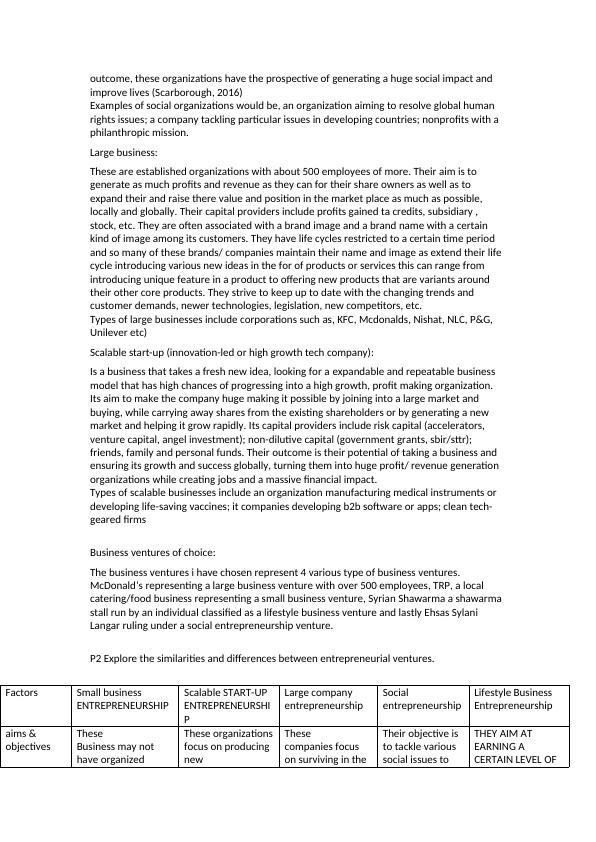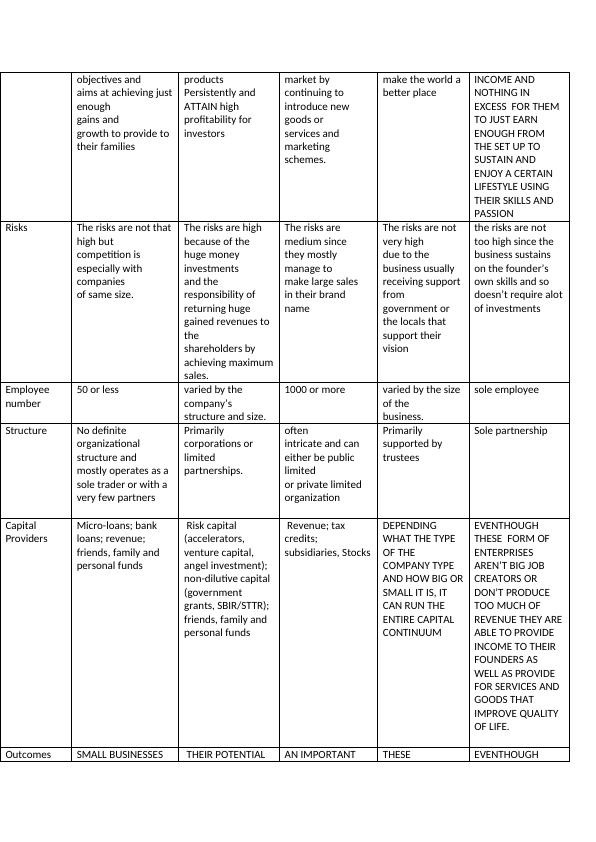Entrepreneurial Venture & The Entrepreneurial Mindset
Added on 2020-09-27
26 Pages13832 Words130 Views
Assessment Submission & DeclarationQualificationUnit number and titlePearson BTEC Higher National Diploma in Business (rqf)09. Entrepreneurship & Small Business Management (level 4)Student nameAssessor nameMinahil SajidXxx Yyy ZzzDate issuedCompletion dateSubmitted onMonday, 13th January 2020Thursday, 30th April 202030/4/20Assignment TitleEntrepreneurial Venture & The Entrepreneurial MindsetAssessment CriteriaTask NumberEvidence Page NumberPass 1Task 1Pass 2Task 1Pass 3Task 3Pass 4Task 3Pass 5Task 2Pass 6Task 2Pass 7Task 2Merit 1Task 1Merit 2Task 3Merit 3Task 2Merit 4Task 2Distinction 1Task 1Distinction 2Task 3Distinction 3Task 2Distinction 4Task 2PlagiarismPlagiarism is a particular form of cheating. Plagiarism must be avoided at all costs and students who break the rules, however innocently, may be penalised. It is your responsibility to ensure that you understand correct referencing practices. As a university level student, you are expected to use appropriate references throughout and keep carefullydetailed notes of all your sources of materials for material you have used in your work, including any material downloaded from the Internet.Learner DeclarationI certify that the assignment submission is entirely my own work and I fully understand the consequences of plagiarism. I understand that making a false declaration is a form of malpractice.Student Signature: Minahil SajidDate: 30.2.20

Table of contentsIntroduction:..............................................................................................................................................3LO1 Explore and illustrate the range of venture types that might be considered ...................................4P1 Examine different types of entrepreneurial ventures and explain how they relate to the typology ofentrepreneurship.......................................................................................................................................4Business Venture:......................................................................................................................................4Types of business ventures:.......................................................................................................................4Small Business:...........................................................................................................................................4Social Good Organizations/Businesses:.....................................................................................................4Large business:...........................................................................................................................................5Scalable start-up (innovation-led or high growth tech company):............................................................5Business ventures of choice:......................................................................................................................5P2 Explore the similarities and differences between entrepreneurial ventures.......................................5similarities and differences between entrepreneurial ventures...............................................................5M1 Investigate a diverse range of entrepreneurial ventures to demonstrate an understanding of entrepreneurship in both the public and corporate sector. private sector:.............................................7public sector:..............................................................................................................................................7D1 Critically examine the scope, development and growth of entrepreneurial ventures........................8scope, development and growth of entrepreneurial ventures.................................................................8P4 Explain the importance of small businesses and business start-ups to the growth of the social economy...................................................................................................................................................13M2 Evaluate the differences small, medium and large businesses make to the economy, applying relevant data and statistics......................................................................................................................14SME:.........................................................................................................................................................14LO3 Determine and assess the key aspects of an entrepreneurial mindset...........................................16P5 Determine the characteristic traits and skills of successful entrepreneurs that differentiate them from other business managers................................................................................................................16Vision:.......................................................................................................................................................16Flexibility:.................................................................................................................................................16Passion:....................................................................................................................................................16Risk Taker:................................................................................................................................................16Strong Work Ethic:...................................................................................................................................17A good entrepreneur has strong work ethics. They often follow being punctual, being the first to arrive and last to leave. They would know check in even on off days making sure everything is coming together and that results live up to their expectations. They make sure to set a good solid example forall their employees to follow...................................................................................................................17Team Work:..............................................................................................................................................17Resilience:................................................................................................................................................17P6 Assess how aspects of the entrepreneurial personality reflect entrepreneurial motivation and mindset....................................................................................................................................................17M3 Explore and examine different lines of argument relating to entrepreneurial characteristics........18There is an association between entrepreneurial tendencies and personality traits of individuals. In some cases personality traits serve as a hinder for some people. Sometimes individual fortunate enough to posses both while other times they’re not............................................................................18D3 Analyzing the characteristic skills, traits and motivational drivers of at least two successful entrepreneurs with examples:.................................................................................................................20LO4 Examine the different environments that foster or hinder entrepreneurship................................21P7 Examine, using relevant examples, how background and experience can hinder or foster entrepreneurship.....................................................................................................................................21D4 Critically analyse how background and experience influences entrepreneurs, both positively and negatively, by comparing and contrasting examples..............................................................................22Conclusion:...............................................................................................................................................23REFERENCES:............................................................................................................................................24

Introduction:Entrepreneurship is taking an idea, processing it and then launching while executing it while

acknowledging its financial and managerial risks. An individual that takes these risks and setting a business for financial gains are known asentrepreneurs. There are various types of business ventures and entrepreneurs require having specific skills and traits that help them run a business empire. Experience and personal background affect entrepreneurship in multiple ways that can encourage or obstruct a business. The assignment would allow us to focus various types of business ventures and research on the effect they have on economy, as well as the abilities andmindset required to set up a business dealt with in detail linking them back to the ways in which experience and personal background influence a start-up business. LO1 Explore and illustrate the range of venture types that might be considered entrepreneurialP1 Examine different types of entrepreneurial ventures and explain how they relate to the typology of entrepreneurship. Business Venture:It’s a set up formed with the intention of gaining financial gains.Often individuals or multiple parties invest in these venture with prospect of the business delivering to them financial gains.Types of business ventures:Small Business: A enterprise that is owned independently by an individual or partnership and for the fake of gaining financial profit. It is often not dominant in its field. It aims at emerging into an abiding business that is commercially successful as well as sustainable, with a possible pass-on to a family member or sale to a worker. Their aim at success is limited to being able to provide for their family and make a reasonable profit, not to rule the market. It is often funded via micro-loans; bank loans; revenue; friends, family and personal funds. Small businesses are not run by too many employees but are capable of generating payroll taxes and jobs. They supply goods and services that are vital elements of a city’s infrastructure, as well as leisure goods and retail.(Drucker, 2014)Its examples include, cafes; retail stores; construction firms; agricultureLifestyle business (includes micro-enterprises and freelancers): Abusinessset up that is operated by its founders with the objective of earning a certain level of income and nothing in excess or for them to just earn enough from the set up to sustain and enjoy a certain lifestyle. These set ups are mainly based off of the founder’s skills, strengths and passions. The aim of these businesses is to gain them earnings that would last them just long enough. They aspire to gain this using self-direction along with their passion and skills. It often doesn’t require any external funds, little to no amount of money is needed to set up this type of business. Eventhough these form of enterprises aren’t big job creators or don’t produce too much of revenue they are able to provide income to their founders as well as provide for services and goods that improve quality of life.The type of businesses it includes are self-employed individuals; one-person firms; very smalloperations, etc.Social Good Organizations/Businesses: A business that revolves around coming with with innovative ideas to resolve social issues and promote causes that would bring about betterment in the environment as well as society. Its aim is to work for various social causes for the sake of society, to make the world a better place to live in, their objective is to provide social work and no financial gains. It aspires to maximize influence in a durable long-lasting manner. Depending what the type of the company type and how big or small it is, it can run the entire capital continuum. As an

outcome, these organizations have the prospective of generating a huge social impact and improve lives (Scarborough, 2016)Examples of social organizations would be, an organization aiming to resolve global human rights issues; a company tackling particular issues in developing countries; nonprofits with a philanthropic mission.Large business: These are established organizations with about 500 employees of more. Their aim is to generate as much profits and revenue as they can for their share owners as well as to expand their and raise there value and position in the market place as much as possible, locally and globally. Their capital providers include profits gained ta credits, subsidiary , stock, etc. They are often associated with a brand image and a brand name with a certain kind of image among its customers. They have life cycles restricted to a certain time period and so many of these brands/ companies maintain their name and image as extend their life cycle introducing various new ideas in the for of products or services this can range from introducing unique feature in a product to offering new products that are variants around their other core products. They strive to keep up to date with the changing trends and customer demands, newer technologies, legislation, new competitors, etc. Types of large businesses include corporations such as, KFC, Mcdonalds, Nishat, NLC, P&G, Unilever etc)Scalable start-up (innovation-led or high growth tech company): Is a business that takes a fresh new idea, looking for aexpandableand repeatable business model that has high chances of progressing into a high growth, profit making organization. Its aim to make the company huge making it possible by joining into a large market and buying, while carrying away shares from the existing shareholders or by generating a new market and helping it grow rapidly. Its capital providers include risk capital (accelerators, venture capital, angel investment); non-dilutive capital (government grants, sbir/sttr); friends, family and personal funds. Their outcome is their potential of taking a business and ensuring its growth and success globally, turning them into huge profit/ revenue generation organizations while creating jobs and a massive financial impact.Types of scalable businesses include an organization manufacturing medical instruments or developing life-saving vaccines; it companies developing b2b software or apps; clean tech-geared firmsBusiness ventures of choice:The business ventures i have chosen represent 4 various type of business ventures. McDonald’s representing a large business venture with over 500 employees, TRP, a local catering/food business representing a small business venture, Syrian Shawarma a shawarma stall run by an individual classified as a lifestyle business venture and lastly Ehsas Sylani Langar ruling under a social entrepreneurship venture. P2 Explore the similarities and differences between entrepreneurial ventures.FactorsSmall business ENTREPRENEURSHIPScalable START-UP ENTREPRENEURSHIPLarge company entrepreneurshipSocial entrepreneurshipLifestyle BusinessEntrepreneurshipaims & objectivesTheseBusiness may not have organized These organizationsfocus on producing newThesecompanies focuson surviving in the Their objective is to tackle various social issues to THEY AIM AT EARNING A CERTAIN LEVEL OF

objectives andaims at achieving justenoughgains andgrowth to provide to their familiesproductsPersistently andATTAIN highprofitability forinvestorsmarket bycontinuing to introduce newgoods orservices andmarketing schemes. make the world a better placeINCOME AND NOTHING IN EXCESS FOR THEM TO JUST EARN ENOUGH FROM THE SET UP TO SUSTAIN AND ENJOY A CERTAIN LIFESTYLE USING THEIR SKILLS AND PASSIONRisksThe risks are not thathigh butcompetition isespecially with companiesof same size.The risks are highbecause of the huge money investmentsand theresponsibility of returning huge gained revenues to theshareholders byachieving maximumsales. The risks aremedium sincethey mostly manage tomake large salesin their brand name The risks are notvery highdue to the business usually receiving support fromgovernment orthe locals that support their vision the risks are not too high since the business sustains on the founder’s own skills and sodoesn’t require alotof investmentsEmployee number50 or lessvaried by the company’sstructure and size. 1000 or morevaried by the size of thebusiness. sole employeeStructureNo definiteorganizationalstructure andmostly operates as a sole trader or with a very few partners Primarilycorporations orlimitedpartnerships. oftenintricate and can either be public limitedor private limitedorganization Primarily supported by trusteesSole partnershipCapital ProvidersMicro-loans; bank loans; revenue; friends, family and personal funds Risk capital (accelerators, venture capital, angel investment); non-dilutive capital (government grants, SBIR/STTR); friends, family and personal funds Revenue; tax credits; subsidiaries, StocksDEPENDING WHAT THE TYPE OF THE COMPANY TYPE AND HOW BIG ORSMALL IT IS, IT CAN RUN THE ENTIRE CAPITAL CONTINUUMEVENTHOUGH THESE FORM OF ENTERPRISES AREN’T BIG JOB CREATORS OR DON’T PRODUCE TOO MUCH OF REVENUE THEY AREABLE TO PROVIDE INCOME TO THEIR FOUNDERS AS WELL AS PROVIDE FOR SERVICES AND GOODS THAT IMPROVE QUALITY OF LIFE.OutcomesSMALL BUSINESSES THEIR POTENTIAL AN IMPORTANT THESE EVENTHOUGH

End of preview
Want to access all the pages? Upload your documents or become a member.
Related Documents
Entrepreneurship & Small in Businesslg...
|12
|4937
|81
T/508/0495 Entrepreneurship and Small Business Managementlg...
|27
|6360
|189
Entrepreneurship and Small Business Management PDFlg...
|84
|9422
|120
Diploma in Business Assignment PDFlg...
|44
|14566
|76
Assignment About the Front Sheet 2022lg...
|82
|23037
|12
Higher National Diploma in Business Assignment 2022lg...
|32
|7570
|10
